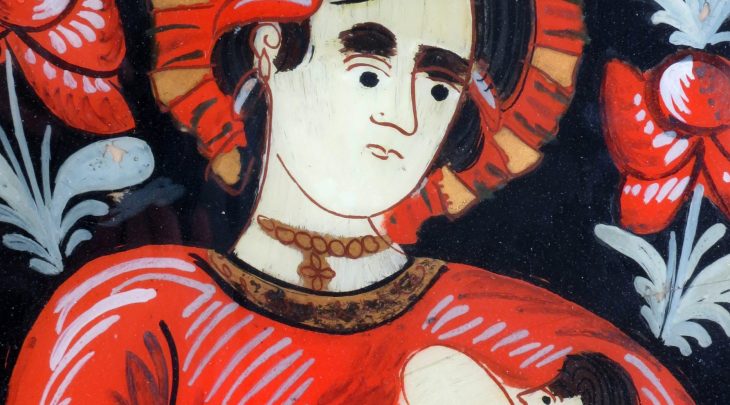

Polish cradle of glass painting
Currently the Podhale region has the largest number of glass painters in entire Europe. Where did the love for this art come from in this region of Poland?
Saints came first
The first paintings on glass came to the Podhale region in the form of sacred images in the second half of the 18th century. In a highlander’s room, they were hung under a decorative slat running most often along the entire length of the wall. They were hung in a row above the table, thus creating a kind of pantheon of holy figures watching over the inhabitants. The number of paintings in a cottage was an indication of wealth. It was believed that patrons could help and protect from misfortune. For example, in case of danger of flooding, people used to pray to St. John of Nepomuk. The image of the Holy Family extended protection to all household members. St. Florian was supposed to protect against fire, St. Barbara – against lightning, St. Anna was the protector of highlander’s wives, and St. Martin was the patron saint of farm work. Glass paintings were usually bought from travelling picture-makers. They were often sold by glassmakers who distributed them along with window panes. The sale of saints’ images was combined with a special ceremonial: kneeling, praying and even reading Gospel passages.
Bloody paper revolution
The “disadvantage” of paintings made on glass was that they could break very easily. For this reason, when in the second half of the 19th century the mass production of colour chromolithographic prints and lithographs began, people quickly switched into “paper” holy images. Reverend Jan Stolarczyk, the parish priest of Zakopane, recommended destroying the “daubs” painted on glass, as he considered them to be inept caricatures of saints. They were smashed and thrown into streams. Even Stanisław Witkiewicz in his reportage from the Tatra Mountains “Na przełęczy” (1891), when describing a cottage in the Podhale region, devoted just one sentence to the mention of glass paintings: One whole wall is hung with terrible yet original paintings made on glass, which, with their gloom and naivety, stand out from the screaming gimcrack of the adjacent German lithographs. This art was extremely different from the positivist aesthetics Witkiewicz used in his paintings.
Revival of glass painting
The Expressionists, however, were fascinated by painting on glass. In the inter-war period, painting on glass slowly began to return to favour. The renaissance of this art occurred mainly due to the cultural policy in the period of Polish People’s Republic. The aim was for the working people, among other things, to meet in song and dance ensembles, to participate in a creative way – all in order to build a sense of unity and satisfaction with the system.
Creators
Janina Marcińczak – Maślanka from Nowy Targ has been involved in painting on glass for over 40 years. She acquired her painting skills in the “Wizja” Amateur Visual Artist’s Club in the Municipal Cultural Centre in Nowy Targ. She is a member of the Polish Folk Arts Society. Her paintings are dominated by religious motifs, mainly representations of the Virgin Mary. Janina Marcińczak-Maślankowa’s paintings are presented at many vernissages throughout Poland.
Zofia Fortecka is an artist living and working in Zakopane. Her home and studio are located in Krzeptówki, where her ancestors from the Stopek and Krzeptowski families have lived for generations. She made her first painting attempts in the early 1980s. The artist creates unique miniatures on glass composed in the form of triptychs and crosses. Her works feature mainly biblical themes, fascinating Lives of the Saints, images of Madonna, as well as scenes from medieval life. In 1987, the Ministry of Culture and Arts granted Zofia Fortecka the status of professional artist. Her works can be found in museum and private collections in Poland and abroad. Her exhibitions outside Europe have reached e.g. the United States and Mexico.


